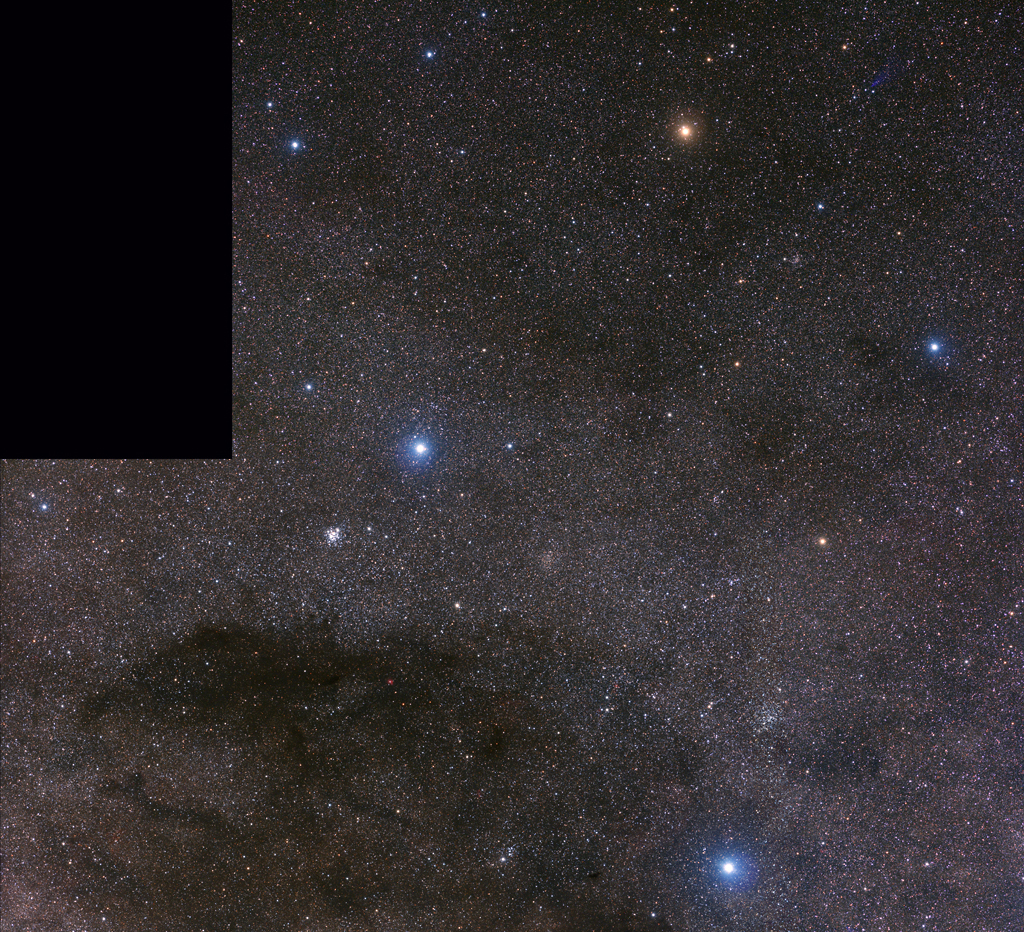 |
CHAMÄLEON + ONJALA OBSERVATORY DeepSky | SITEMAP HOME CHAMÄLEON |
|
 |
|||
| « back to overview widefield | Load higher resolution (1800 x 1800 Pixel 3500 x 3500 Pixel) | Object description |

The Southern Cross is one of the most famous constellations of the southern night sky. It is a small in area, but very prominent constellation. Before the invention of modern navigation systems it was used to determine the cardinal points on the Earth's surface. For this purpose one extends the distance from Gacrux to Acrux in a straight line (see labeled picture) about 5 times. at this point of the sky lies the southern celestial pole. From this point you drop a perpendicular to the horizon and there is exactly geographically SOUTH.
The Southern Cross is not one of the 48 classical constellations of antiquity. The main stars were known, because it is observable from the Mediterranean region just above the horizon, but at that time they were assigned to the constellation Centaurus.
The stars of the cross as an orientation guide were already known to the navigator Amerigo Vespucci in the 16th century. The star positions were described in more detail by Andrea Corsali in 1515.
The constellation consists of 4 bright stars, Acrux, Becrux, Gacrux and Decrux, which form the cross. They are abbreviations for alpha, beta, gamma and delta in connection with the Latin name of the constellation Crux. In addition, there is a fifth, brighter star, epsilon Cruxis. Alpha and Gamma Crux are visually easy to observe double stars.
Acrux is a triple star system consisting of two blue, luminous stars of spectral classes B1 and B2 (Acrux A1 and Acrus A2) and a somewhat fainter component of spectral class B4 at a wide distance from the two main components, which are approximately equally bright (Acrux A1 is also a spectroscopic double star). They appear distinctly blue in visual observation, to separate the components requires a telescope aperture of 5 to 6 inches, the apparent separation is currently 4 arcseconds. The distance to the solar system is 312 light years, the orbital period of the main components is about 1500 years.
 |
Becrux, also called Mimosa, is a
variable star of the Beta Cephei class 353 light-years away. Becrux is a
spectroscopic binary, but the stars are too close together to separate into
single stars in the telescope. The two stars orbit each other with a period of
about 5 years, the distance is about 8 astronomical units (distance Sun Earth =
1 AU). Gacrux is a binary star consisting of a very luminous red giant star of spectral class M4 and a fainter companion of spectral class A3. The apparent distance between the two stars is just under 130 arcseconds. The distance to the sun is just under 90 light-years. Decrux is like Becrux a variable star of the type Beta Cephei, It is assigned to spectral class B2. Its distance to the solar system is about 345 light-years. It has about 9 times the mass of our Sun and rotates at the equator - like many other B stars - with a period of only 1.3 days extremely fast compared to our Sun (29 days). With an estimated age of less than 30 million years Decrux is a very young star. Epsilon Crucis Crucis is an irregularly variable star whose brightness varies between 3.4 and 4.0m with no discernible period. It is 150 light-years away and is cataloged as spectral class K3. « Click here or the thumbnail to load a large annoted image. |
NGC 4349 is an open star cluster and is classified as type I 2 m according to Trumpler. It contains about 30 stars and its distance to the solar system is about 7100 light-years. NGC 4349 was discovered by James Dunlop on April 30, 1826.
NGC 4439 is an open star cluster and is assigned to type II 1 p according to Trumpler. Its distance to the solar system is about 5800 light-years. NGC 4439 was discovered by James Dunlop on April 30, 1826.
To the left of Acrux shows the image of part of the Coal Sack, a large dark cloud of cold dust and gas that blocks, or weakens, the light from stars behind it. The Coal Sack lies at a distance of about 600 light-years from the solar system.
RCW 71 - also cataloged as Gum 46 or GN 12.47.3 - is a small H-II region ionized by the star HD 311 999 of spectral class O9.5V. Inside is a small open cluster, but its stars are visible only in infrared light.
The RCW catalog (by Rodgers, Campbell, and Whiteoak) is an astronomical catalog of H-II emission regions in the southern Milky Way. It contains 182 objects, including many of the objects in the older Gum Catalog.
The Southern Cross constellation is part of the flags of many countries and states in the Earth's southern hemisphere, see this URL for more details.
 |
 |
 |
 |
 |
 |
 |
| Sun | Moon | Solar System | DeepSky | Widefield | Miscellaneous | Spec. Projects |